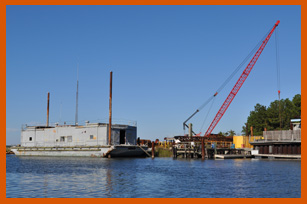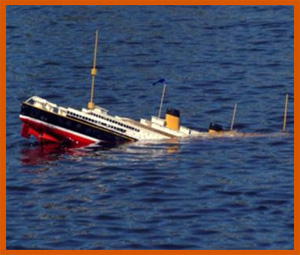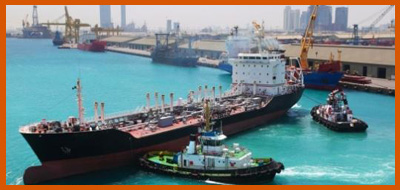The Admiralty Law Section focuses on two main issues:
1) all maritime death and injury claims, and
 2) injuries and wrongful deaths of seamen working on watercraft, longshoremen's claims, harbor workers who work on or near the water, ship repairmen and builders, pleasure boat and jet ski owners and operators, and commercial and recreational divers. Every branch of law has developed its own peculiar or unique concepts. The concepts of offer, acceptance and consideration are unique concept of contract branch of law. Actus reas and mens reas are unique concepts peculiar to criminal law. Negligence, strict liability, and actionable wrongs are some of the unique concepts developed under tort law. Similarly, under the admiralty law there are some unique concepts such as admiralty jurisdiction, charter parties, demurrage, dispatch, bill of lading etc. 2) injuries and wrongful deaths of seamen working on watercraft, longshoremen's claims, harbor workers who work on or near the water, ship repairmen and builders, pleasure boat and jet ski owners and operators, and commercial and recreational divers. Every branch of law has developed its own peculiar or unique concepts. The concepts of offer, acceptance and consideration are unique concept of contract branch of law. Actus reas and mens reas are unique concepts peculiar to criminal law. Negligence, strict liability, and actionable wrongs are some of the unique concepts developed under tort law. Similarly, under the admiralty law there are some unique concepts such as admiralty jurisdiction, charter parties, demurrage, dispatch, bill of lading etc.
Under the admiralty jurisdiction there are certain concepts such as action in rem, arrest of a ship, maritime lien etc which had developed over several centuries due to the exigencies of the sea trade. The transitory nature of ships which always are in a state of motion required the development of these unique concepts so that some degree of control could be exercised to enforce claims against the ships. This is because ships during the course of their voyages create rights and incur liabilities, but the ownerships of these ships are transient and unknown. Therefore, it would be very difficult to trace the true owner of a ship and lodge claim against owner.
The purpose of this paper is to trace the historical development of admiralty jurisdiction, the jurisdictional concepts such as the in rem jurisdiction, the maritime lien and the arrest of ship, the efforts in India to codify admiralty jurisdiction by the introduction of the Admiralty Bill, 2005, and the current status of the Indian law which requires immediate reform.
Historical Perspective:
Admiralty jurisdiction exercised by the Indian Courts is those conferred on them during the British Regime. Initially maritime disputes were heard by ordinary civil courts. In 1360 the King of England granted to the ‘Admiral of the Fleets’ the power to hear and decide maritime disputes such as piracy, maritime civil disputes, maritime torts and charter party disputes. These admiralty courts applied the ‘law of merchant’ or ‘lex mercatoria’ and not the English common law. This had resulted in a serious conflict between the admiralty courts and the common law courts in England. Consequently, the Statutes of 1389 and 1391 were passed demarcating the jurisdiction of admiralty courts and of the common law courts. The admiralty courts had no jurisdiction to decide disputes “within the realm” of the Great Britain. However, these Statutes vested concurrent jurisdiction on both admiralty courts and common law courts on criminal matters on board of a ship in river mouth and estuaries, which were “within the realm”.
The Statutes of 1389 and 1391 could not prevent the conflict between the admiralty courts and the common law courts in England. In the procedural matters the admiralty courts were applying the Civil Law and not the English law of procedure. This had further aggravated the conflict between the admiralty courts and the common law courts. The common law courts also by way of interpretation took away from the admiralty courts jurisdiction to decide on disputes pertaining to contracts made on land but to be performed in sea. This anomaly was set right by the Admiralty Courts Act of 1840 which restored this jurisdiction on admiralty courts to decide on disputes pertaining to contracts made on land but to be performed in sea. Under Section 6 of the Admiralty Courts Act the High Court was conferred power to decide disputes on inward cargo. In 1844 criminal law jurisdiction was granted to regular courts of common law. In 1861 the Admiralty Courts Act conferred larger power on the High Court of Admiralty. In 1873 the admiralty jurisdiction was transferred to the High Court  of Justice by the Supreme Court of Judicature Act, 1873. Thus, in England for the first time the High Court of Admiralty was merged with the High Court of Justice. The Administration of Justice Act, 1920 further widened theAdmiralty Jurisdiction. In 1925 the Supreme Court of Judicature (Consolidation) Act further consolidated the jurisdiction of High Courts of Justice. Again in 1956 the jurisdiction was further consolidated. In 1970, the Administration of Justice Act of 1970 created the admiralty courts which were made as a part of the Queen’s Bench Division and the admiralty jurisdiction of the High Court was transferred to the said tribunal. In 1981 by the Supreme Court Act of 1981 the admiralty jurisdiction was conferred on claims with respect to possession of ships, mortgages or charges, damages received or done by ships and loss or injury or life caused by ships. of Justice by the Supreme Court of Judicature Act, 1873. Thus, in England for the first time the High Court of Admiralty was merged with the High Court of Justice. The Administration of Justice Act, 1920 further widened theAdmiralty Jurisdiction. In 1925 the Supreme Court of Judicature (Consolidation) Act further consolidated the jurisdiction of High Courts of Justice. Again in 1956 the jurisdiction was further consolidated. In 1970, the Administration of Justice Act of 1970 created the admiralty courts which were made as a part of the Queen’s Bench Division and the admiralty jurisdiction of the High Court was transferred to the said tribunal. In 1981 by the Supreme Court Act of 1981 the admiralty jurisdiction was conferred on claims with respect to possession of ships, mortgages or charges, damages received or done by ships and loss or injury or life caused by ships.
Admiralty Jurisdiction in India
The admiralty jurisdiction of Indian courts started with the Letters Patent which conferred admiralty jurisdiction on the Chartered High Courts of Calcutta, Bombay and Madras. Clause 32 of the Letters Patent of 1865 stated that the Letters Patent Court “shall have and exercise all such civil and maritime jurisdiction as may now be exercised by the said High Court as admiralty or vice-admiralty”. Subsequently, this jurisdiction was enlarged for colonial courts by the Colonial Courts of Admiralty Act, 1890, which was extended to India by the Colonial Courts of Admiralty (India) Act, 1891. Thus by the latter Act the Chartered High Courts in India were vested with the admiralty jurisdiction which was enjoyed by the High Court of England.
This position continued under the Government of India Act, 1915. Section 106 of the said Act specifically provided that all the High Courts established by the Letters Patent were courts of record and had such original and appellate jurisdiction, including admiralty jurisdiction. Section 223 of the Government of India Act, 1935 also stated that the High Courts shall have the powers and jurisdiction that they had enjoyed before. After independence and the coming into force of the Constitution of India the admiralty jurisdiction was protected by Article 225 which stated as follows:
“The jurisdiction of and the law administered in any existing High Court, and the respective powers of the judges thereof in relation to the administration of justice in the Courts, including the power to make rules of Court and to regulate the sittings of the Court and of the members thereof sitting alone or in Division Courts, shall be the same as immediately before the commencement of this Constitution.”
Thus the current position on the admiralty jurisdiction after the advent of the Constitution of India has been summarized by the Supreme Court in M.V. Elisabeth v Harwan Investments and Trading Ltd. [(1993) Supp. 2 SCC 433] in the following words:
“The British statute assimilating Indian High Courts to the position of the English High Court in respect of admiralty jurisdiction is an enabling legislation and it is but one of the strands of jurisdiction vested in the High Court by virtue of the constitutional provisions. The jurisdiction of the High Court is governed by the Constitution and the laws, and the continuance in force of the existing laws is not a fetter but an additional source of power. Access to court for redressal of grievance being an important right of every person, it is essential that the jurisdiction of the courts is construed harmoniously and consistently with its vital function in that respect, so that absence of legislation will not jeopardise that right.
 “Admiralty jurisdiction, despite the peculiarities of its origin and growth rooted as it is in history and nurtured by the growing demands of international trade is nevertheless a part of the totality of jurisdiction vested in the High Court as a superior court of record, and it is not a distinct and separate jurisdiction as was once the position in England before the unification of courts. The 1890 and 1891 Acts specifically conferred admiralty jurisdiction on the Indian High Courts by reason of their being courts of unlimited jurisdiction. These Acts did not create any separate or distinct jurisdiction, but merely equated the Indian High Courts to the position of the England High Court (united and consolidated as that Court has been since 1875) for the exercise of admiralty powers within the jurisdiction of the former”. “Admiralty jurisdiction, despite the peculiarities of its origin and growth rooted as it is in history and nurtured by the growing demands of international trade is nevertheless a part of the totality of jurisdiction vested in the High Court as a superior court of record, and it is not a distinct and separate jurisdiction as was once the position in England before the unification of courts. The 1890 and 1891 Acts specifically conferred admiralty jurisdiction on the Indian High Courts by reason of their being courts of unlimited jurisdiction. These Acts did not create any separate or distinct jurisdiction, but merely equated the Indian High Courts to the position of the England High Court (united and consolidated as that Court has been since 1875) for the exercise of admiralty powers within the jurisdiction of the former”.
In this judgement the Supreme Court also expressed its anguish that the “rights and interests of citizen of the independent sovereign state continued to be governed by legislations enacted for colonies by the British Parliament” and that “[v]arious provisions in 1890 Act have been rendered not only anomalous but even derogatory to the sovereignty of the State”.
Jurisdictional Concepts
Jurisdiction is part of the sovereignty of courts in a country. Jurisdiction is exercised by a court either in personam or in rem. In personam jurisdiction is exercised over the person who is present within the jurisdiction of the court. In personam jurisdiction can be either territorial or pecuniary or subject matter. In rem jurisdiction is exercised over a res or a property which is present within the jurisdiction of the court. Here instead of a living person the res or property is treated as a person and jurisdiction is exercised by the court. The res is the defendant in the case.
Action in rem and Arrest of Ships
In rem jurisdiction is a unique feature of admiralty jurisdiction. In rem jurisdiction is commenced before an admiralty court by initiating an action in rem. It is a peculiar concept known only to Anglo-Saxon law. In this case jurisdiction is assumed by court by the arrest of a ship in respect of any ‘maritime claim’ irrespective of the place of registration of the ship or the nationality, place of business, domicile, or residence of its owner or the place where the cause of action arose. Thus this concept is markedly different from Sections 15 to 20 CPC where the jurisdiction of a court depends on the place of residence or business of the defendant, the place where the subject matter of the dispute is located or the place where the cause of action has taken place. Action in rem can also be commenced against a sister ship in a claim. The foundation of action in rem is the maritime lien.
Arrest of a ship in pursuance of an action in rem is to be distinguished from other kinds of arrests of ships. Action in rem is different from the arrest of a ship in execution of a decree obtained against the owner of the ship. In the former case the ship is treated as a person having rights and liabilities, which are sometimes distinct from the owner. Its liabilities are enforced by process and decree against the vessel. The judgment against the ship is binding upon all persons interested in her and conclusive upon the world.
Ships are also arrested by way of detention or confiscation by coastal authorities for violating customs laws, safety measures or health laws. Coastal states also arrest ships in exercise of their criminal jurisdiction when crimes are committed on board the vessel for the purpose of effecting arrest of the offender or for the purpose of criminal investigation. Similarly, civil courts arrest a ship by seizure in execution or satisfaction of judgments. All these types of arrests are to be distinguished from the arrest of a ship in pursuance of an action in rem where in the ship is treated as a defendant and the action is commenced by the arrest of the ship.
International Conventions on Arrest of ships
Ships incur liabilities in the course of their voyage; subjecting themselves to the jurisdiction of States in whose water they enter. Traditionally, ships were arrested under the admiralty jurisdiction for the enforcement of maritime liens or seized in execution or satisfaction of judgment in legal actions arising out of maritime liens such as, collisions, salvage, loss of life, personal injury, or claim or damage to goods. However, the law and practice relating to the arrest of ships varied from country to country. Therefore efforts were made for the unification and harmonization of the laws relating to the arrest of ships. This had lead to International Conventions which laid down uniform law on the arrest of ships. The 1952 International Convention Relating to the Arrest of Seagoing Ships, Brussels was the first Convention on this topic. This Convention under Article I (a) defined “arrest” as meaning the detention of a ship by judicial processes to secure a maritime claim, but did not include the seizure of a ship in execution or satisfaction of a judgment. Thus this Convention made a clear distinction between the arrest of a ship to secure a maritime claim from that of the arrest of a ship in execution or satisfaction of a judgment. The subsequent Geneva Convention on Arrest of Ships, 1999 also retained this distinction by defining “arrest” as meaning, any detention or restriction on removal of a ship by order of a court to secure a maritime claim, but did not include the seizure of a ship in execution or satisfaction of a judgment or other enforceable instrument.
Thus, the above two Conventions had very clearly defined the arrest of a ship in exercise of admiralty jurisdiction as distinct from the normal arrest of a ship to acquire jurisdiction to commence an action, or to obtain security for the satisfaction of the claim decreed, or in execution of a decree. In all these latter cases, the defendant is the owner of the ship and not the ship herself and the ship is detained until the matter has been finally settled by a competent court. The arrest brings the vessel under the custody of the Marshall or authorized officer. No attachment is made when the defendant accepts service or pays the money into the court. The arrest of a ship in exercise of an action in rem is unknown to the civil law wherein all proceedings are initiated only by action in personam. A ship is detained under the Civil Law only when the court is convinced that the Plaintiff would lose his security if the ship leaves. The proceedings under the Civil Law, unlike under the Anglo-Saxon Law, are not limited to maritime liens or claims.
Maritime Liens:
 Existence of a maritime lien is the foundation for initiating an action in rem for the arrest of a ship under the admiralty jurisdiction. Like any other lien, a maritime lien is also a claim or privilege upon a thing to be carried into effect by legal process. However, the distinction between a common law lien and the maritime lien is that in the case of maritime lien, the process is by way of proceedings in rem. The claim or privilege travels with the thing into whosesoever possession it may come and it is inchoate from the moment the claim or privilege attaches. When carried into effect by legal process by proceedings in rem, the maritime lien relates back to the period when it got attached first. Thus the two key aspects of the maritime lien are that it is a right to a part of the property in res and that it is a privileged claim upon a ship in respect of services rendered to or injury caused by the ship. Existence of a maritime lien is the foundation for initiating an action in rem for the arrest of a ship under the admiralty jurisdiction. Like any other lien, a maritime lien is also a claim or privilege upon a thing to be carried into effect by legal process. However, the distinction between a common law lien and the maritime lien is that in the case of maritime lien, the process is by way of proceedings in rem. The claim or privilege travels with the thing into whosesoever possession it may come and it is inchoate from the moment the claim or privilege attaches. When carried into effect by legal process by proceedings in rem, the maritime lien relates back to the period when it got attached first. Thus the two key aspects of the maritime lien are that it is a right to a part of the property in res and that it is a privileged claim upon a ship in respect of services rendered to or injury caused by the ship.
Traditionally, only five types of claims alone are treated as maritime liens. They are (i) Damage done by a ship, (b) Salvage, (c) Seaman or Master’s wages, (d) Master’s disbursement and (e) Bottomry. The Supreme Court has also accepted these five types of claims as only constituting maritime liens in Epoch Enterrepots v MV Won Fu [(2003) 1 SCC 305]. However, subsequent efforts on unification of the law on maritime liens lead to International Conventions, which have widened the scope of maritime liens by adding more heads of claims under maritime liens. These Conventions are the International Convention for Unification of Certain Rules Relating to Maritime Liens and Mortgages at Brussels, 1926, The Revised International Convention for Unification of Certain Rules Relating to Maritime Liens and Mortgages at Brussels, 1967, and the Geneva Convention on Maritime Liens and Mortgages, 1993.
India and International Conventions
India is not party to any of the International Conventions relating to the arrest of ships or those relating to maritime liens. However, the Supreme Court has in MV Elisabeth’s case has specifically held that the principles covered under these Conventions are part of the laws of India and applicable to courts while exercising admiralty jurisdiction. The Supreme Court has stated as follows:
“The principles incorporated in the Conventions themselves derived from the common law of nations as embodying the felt necessities of international trade and are as such part of the common law of India and applicable for the enforcement of maritime claims against foreign ships.”
In the light of the above clear statement of Indian law by the Supreme Court of India, the principles dealt with by all the International Conventions relating to arrest of ships and maritime liens are part of the existing law on admiralty jurisdiction in India. |